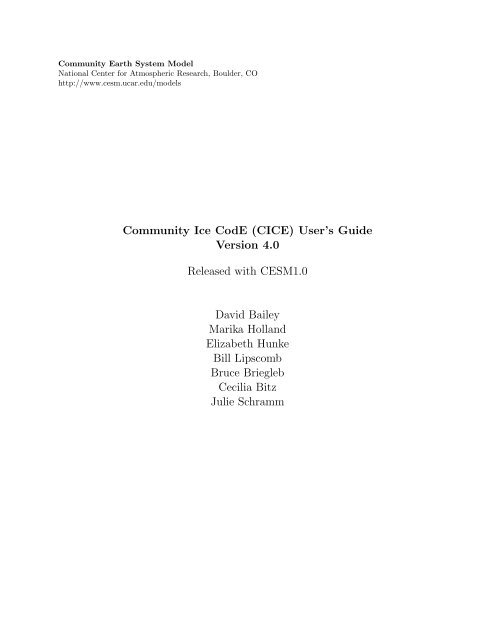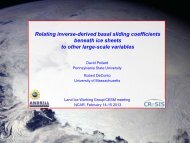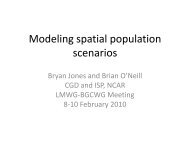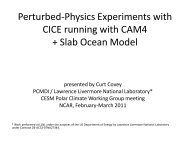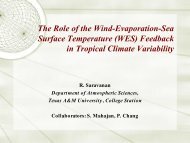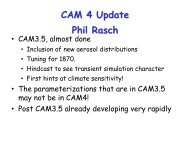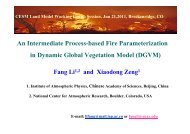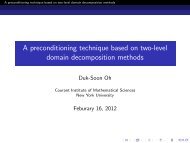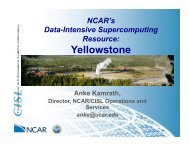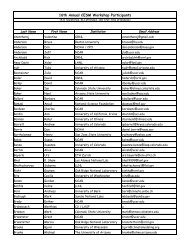Community Ice CodE (CICE) User's Guide Version 4.0 ... - CESM
Community Ice CodE (CICE) User's Guide Version 4.0 ... - CESM
Community Ice CodE (CICE) User's Guide Version 4.0 ... - CESM
Create successful ePaper yourself
Turn your PDF publications into a flip-book with our unique Google optimized e-Paper software.
<strong>Community</strong> Earth System Model<br />
National Center for Atmospheric Research, Boulder, CO<br />
http://www.cesm.ucar.edu/models<br />
<strong>Community</strong> <strong>Ice</strong> <strong>CodE</strong> (<strong>CICE</strong>) User’s <strong>Guide</strong><br />
<strong>Version</strong> <strong>4.0</strong><br />
Released with <strong>CESM</strong>1.0<br />
David Bailey<br />
Marika Holland<br />
Elizabeth Hunke<br />
Bill Lipscomb<br />
Bruce Briegleb<br />
Cecilia Bitz<br />
Julie Schramm
Contents<br />
1 Introduction 2<br />
1.1 What’s new in <strong>CICE</strong>4? . . . . . . . . . . . . . . . . . . . . . . . . . . . . . . . . . . . . . . . . 2<br />
2 The <strong>CICE</strong> Scripts 3<br />
2.1 Coupled Model Scripts . . . . . . . . . . . . . . . . . . . . . . . . . . . . . . . . . . . . . . . . 4<br />
2.2 The Build Environment . . . . . . . . . . . . . . . . . . . . . . . . . . . . . . . . . . . . . . . 4<br />
2.2.1 <strong>CICE</strong> Preprocessor Flags . . . . . . . . . . . . . . . . . . . . . . . . . . . . . . . . . . 5<br />
3 Namelist Variables 5<br />
3.1 Changing the timestep . . . . . . . . . . . . . . . . . . . . . . . . . . . . . . . . . . . . . . . . 5<br />
3.2 Writing Output . . . . . . . . . . . . . . . . . . . . . . . . . . . . . . . . . . . . . . . . . . . . 7<br />
3.3 Model Physics . . . . . . . . . . . . . . . . . . . . . . . . . . . . . . . . . . . . . . . . . . . . . 7<br />
3.4 Tracer Namelist . . . . . . . . . . . . . . . . . . . . . . . . . . . . . . . . . . . . . . . . . . . . 9<br />
3.5 Prescribed <strong>Ice</strong> Namelist . . . . . . . . . . . . . . . . . . . . . . . . . . . . . . . . . . . . . . . 9<br />
3.6 Grid Namelist . . . . . . . . . . . . . . . . . . . . . . . . . . . . . . . . . . . . . . . . . . . . . 9<br />
3.7 Domain Namelist . . . . . . . . . . . . . . . . . . . . . . . . . . . . . . . . . . . . . . . . . . . 10<br />
3.8 PIO Namelist . . . . . . . . . . . . . . . . . . . . . . . . . . . . . . . . . . . . . . . . . . . . . 10<br />
3.9 Example Namelists . . . . . . . . . . . . . . . . . . . . . . . . . . . . . . . . . . . . . . . . . . 10<br />
3.9.1 Example 1: <strong>CESM</strong> Fully Coupled . . . . . . . . . . . . . . . . . . . . . . . . . . . . . . 11<br />
3.9.2 Example 2: History File Namelist . . . . . . . . . . . . . . . . . . . . . . . . . . . . . 12<br />
4 Model Input Datasets 13<br />
5 Run Types 14<br />
6 Prescribed <strong>Ice</strong> Mode 14<br />
7 Prescribed Aerosol Mode 14<br />
8 Changing the Number of <strong>Ice</strong> Thickness Categories 14<br />
9 Output Data 15<br />
9.1 Stdout Output . . . . . . . . . . . . . . . . . . . . . . . . . . . . . . . . . . . . . . . . . . . . 15<br />
9.2 Restart Files . . . . . . . . . . . . . . . . . . . . . . . . . . . . . . . . . . . . . . . . . . . . . 16<br />
9.3 History Files . . . . . . . . . . . . . . . . . . . . . . . . . . . . . . . . . . . . . . . . . . . . . 16<br />
9.3.1 Caveats Regarding Averaged Fields . . . . . . . . . . . . . . . . . . . . . . . . . . . . 17<br />
9.3.2 Changing Frequency and Averaging . . . . . . . . . . . . . . . . . . . . . . . . . . . . 17<br />
9.3.3 Changing Content . . . . . . . . . . . . . . . . . . . . . . . . . . . . . . . . . . . . . . 18<br />
10 Troubleshooting 20<br />
10.1 Code does not Compile or Run . . . . . . . . . . . . . . . . . . . . . . . . . . . . . . . . . . . 20<br />
10.2 Negative <strong>Ice</strong> Area in Horizontal Remapping . . . . . . . . . . . . . . . . . . . . . . . . . . . . 20<br />
10.3 Thermodynamic Iteration Error . . . . . . . . . . . . . . . . . . . . . . . . . . . . . . . . . . . 21<br />
10.4 Conservation Error . . . . . . . . . . . . . . . . . . . . . . . . . . . . . . . . . . . . . . . . . . 21<br />
10.5 NX does not divide evenly into grid . . . . . . . . . . . . . . . . . . . . . . . . . . . . . . . . 21<br />
10.6 Enabling the Debugger . . . . . . . . . . . . . . . . . . . . . . . . . . . . . . . . . . . . . . . . 21<br />
1
1 Introduction<br />
This User’s <strong>Guide</strong> accompanies the <strong>CESM</strong>1 User’s <strong>Guide</strong>, and is intended for those who would like to run<br />
<strong>CICE</strong> coupled, on a supported platform, and ”out of the box”. Users running <strong>CICE</strong> fully coupled should<br />
first look at the <strong>CESM</strong>1 User’s <strong>Guide</strong>:<br />
http://www.cesm.ucar.edu/models/cesm1.0/cesm doc/book1.html.<br />
It includes a quick start guide for downloading the <strong>CESM</strong>1 source code and input datasets, and information<br />
on how to configure, build and run the model. The supported configurations and scripts for building<br />
the fully coupled model are also described in the <strong>CESM</strong>1 User’s <strong>Guide</strong>. The <strong>CICE</strong> User’s <strong>Guide</strong> is intended<br />
for users interested in making modifications to the ice model scripts or namelists or running the uncoupled<br />
ice model. Users interested in modifying the source code should see the <strong>CICE</strong> Code Reference/ Developer’s<br />
<strong>Guide</strong>.<br />
<strong>CICE</strong>4 is the latest version of the Los Alamos Sea <strong>Ice</strong> Model, sometimes referred to as the <strong>Community</strong><br />
<strong>Ice</strong> <strong>CodE</strong>. It is the result of a community effort to develop a portable, efficient sea ice model that can be<br />
run coupled in a global climate model or uncoupled as a stand-alone ice model. It has been released as the<br />
sea ice component of the <strong>Community</strong> Earth System Model (<strong>CESM</strong>), a fully-coupled global climate model<br />
that provides simulations of the earths past, present and future climate states. <strong>CICE</strong>4 is supported on highand<br />
low-resolution Greenland Pole and tripole grids, which are identical to those used by the Parallel Ocean<br />
Program (POP) ocean model. The high resolution version is best suited for simulating present-day and<br />
future climate scenarios while the low resolution option is used for paleoclimate simulations and debugging.<br />
An uncoupled version of <strong>CICE</strong> is available separately from Los Alamos National Laboratory:<br />
http://oceans11.lanl.gov/trac/<strong>CICE</strong>.<br />
It provides a means of running the sea ice model independent of the other <strong>CESM</strong> components. It reads<br />
in atmospheric and ocean forcing, which eliminates the need for the flux coupler, and the atmosphere, land<br />
and ocean data models. It can be run on a reduced number of processors, or without MPI (Message Passing<br />
Interface) for researchers without access to these computer resources.<br />
The physics in the uncoupled ice model are identical to those in the ice model used in the fully coupled<br />
system. <strong>CICE</strong> is a dynamic-thermodynamic model that includes a subgrid-scale ice thickness distribution<br />
(Bitz et al. (2001); Lipscomb (2001)). It uses the energy conserving thermodynamics of Bitz and Lipscomb<br />
(1999), has multiple layers in each thickness category, and accounts for the influences of brine pockets within<br />
the ice cover. The ice dynamics utilizes the elastic-viscous-plastic (EVP) rheology of Hunke and Dukowicz<br />
(1997). Sea ice ridging follows Rothrock (1975) and Thorndike et al. (1975). A slab ocean mixed layer<br />
model is included. A Scientific Reference is available that contains more detailed information on the model<br />
physics.<br />
An attempt has been made throughout this document to provide the following text convention. Variable<br />
names used in the code are typewritten. Subroutine names are given in italic, and file names are in<br />
boldface.<br />
1.1 What’s new in <strong>CICE</strong>4?<br />
<strong>CICE</strong>4 is an upgraded version of the <strong>Community</strong> Sea <strong>Ice</strong> Model, CSIM5, which was based on <strong>CICE</strong>3, and<br />
was released in June 2004. The model physics are similar to that of CSIM5, but it was decided to move to<br />
<strong>CICE</strong>, the LANL sea ice model for practical reasons. The major changes are:<br />
• The incremental remapping transport scheme is now the default and is available in the modules called<br />
ice transport driver.F90 and ice transport remap.F90. The MPDATA transport scheme, is no<br />
longer supported in <strong>CICE</strong>4. The upwind advection scheme is the only additional option and is contained<br />
in ice transport driver.F90.<br />
• The standalone ice model is now only available through Los Alamos National Laboratory.<br />
2
• Several physics options have been shifted around into other or new modules. For example, most<br />
of ice albedo.F90 is now in ice shortwave.F90. The new module contains all of the shortwave<br />
radiative transfer plus the basic albedo calculations.<br />
• The mechanical redistribution scheme has been changed significantly and is available in ice mechred.F90.<br />
• A new drivers area has been created for modules that are specific to the <strong>CESM</strong> as opposed to the<br />
standalone <strong>CICE</strong> model. The new <strong>CESM</strong> drivers are contained in the cpl mct and cpl share subdirectories.<br />
The ESMF driver (cpl esmf) is still under development. The source subdirectory now contains<br />
driver independent source code for the most part.<br />
• A new bld subdirectory has been introduced which contains <strong>CESM</strong> specific build and configure scripts.<br />
These scripts handle the namelist generation, defaults, and configuration details.<br />
The <strong>CICE</strong> source code is based on the Los Alamos sea ice model <strong>CICE</strong> model version 4. The main source<br />
code is very similar in both versions, but the drivers are significantly different. If there are some topics<br />
that are not covered in the <strong>CICE</strong> documentation, users are encouraged to look at the <strong>CICE</strong> documentation<br />
Hunke and Lipscomb (2008). It is available at Los Alamos National Laboratory at:<br />
http://oceans11.lanl.gov/trac/<strong>CICE</strong>.<br />
2 The <strong>CICE</strong> Scripts<br />
The setup scripts for the coupled model are located in cesm1/scripts. The directory structure of <strong>CICE</strong>4<br />
within <strong>CESM</strong> is shown below.<br />
cesm1 (main directory)<br />
|<br />
|<br />
models--------+--------- scripts<br />
| |<br />
| * * * * *|* * * * *<br />
bld------+------ice *build scripts for*<br />
| | * coupled model *<br />
(Makefile | * * * * * * * * * *<br />
macros) |<br />
cice (active ice component)<br />
|<br />
bld ---------- docs -------+------- src<br />
| |<br />
(<strong>CICE</strong> |<br />
documentation) |<br />
|<br />
|<br />
drivers --- mpi ---+--- serial --- source<br />
|<br />
|<br />
|<br />
cice4 ---- cpl_esmf --+-- cpl_mct ---- cpl_share<br />
3
2.1 Coupled Model Scripts<br />
The <strong>CESM</strong>1 scripts have been significantly upgraded from CCSM3 and are based on a completely different<br />
design philosophy. The new scripts will generate a set of ”resolved scripts” for a specific configuration determined<br />
by the user. The configuration includes components, resolution, run type, and machine. The run and<br />
setup scripts that were previously in the /scripts directory for CCSM3 are now generated automatically.<br />
See the <strong>CESM</strong>1 User’s <strong>Guide</strong> for information on how to use the new scripts:<br />
http://www.cesm.ucar.edu/models/cesm1.0/cesm doc/book1.html.<br />
The file that contains the ice model namelist is now located in $CASE/Buildconf. The script containing<br />
the environment variables used for building the executable file for the ice model is also in $CASE/Buildconf.<br />
The contents of the ice model namelist are described in section 3.<br />
2.2 The Build Environment<br />
The build and configure environment has changed significantly from previous versions of <strong>CESM</strong>. The build<br />
namelist and configure utilities are based on the CAM scripts ().<br />
The configure utility includes setting compile time parameters such as the horizontal grid, the sea ice<br />
mode (prognostic or prescribed), tracers, etc. Additional options can be set using the configure utility such<br />
as the decomposition, and the number of tasks, but these are typically set via <strong>CESM</strong> enviroment variables.<br />
However, the CAM scripts set some of these explicitly through the configure command line. For example<br />
one such configure line in the <strong>CESM</strong> scripts is:<br />
#--------------------------------------------------------------------<br />
# Invoke cice configure<br />
#--------------------------------------------------------------------<br />
set hgrid = "-hgrid $ICE_GRID"<br />
if ($ICE_GRID =~ *T*) set hgrid = "-hgrid ${ICE_NX}x${ICE_NY}"<br />
set mode = "-cice_mode $<strong>CICE</strong>_MODE"<br />
cd $CASEBUILD/ciceconf || exit -1<br />
$CODEROOT/ice/cice/bld/configure $hgrid $mode -nodecomp $<strong>CICE</strong>_CONFIG_OPTS || exit -1<br />
This example sets the horizontal grid and the mode (prognostic or prescribed). The build namelist<br />
utility sets up the namelist which controls the run time options for the <strong>CICE</strong> model. This utility sets namelist<br />
flags based on compile time settings from configure and some standard defaults based on horizontal grids<br />
and other options. The typical execution during the <strong>CESM</strong> configure is:<br />
$CODEROOT/ice/cice/bld/build-namelist -config config_cache.xml \<br />
-csmdata \$DIN_LOC_ROOT -infile ccsm_namelist \<br />
-inputdata $CASEBUILD/cice.input_data_list \<br />
-namelist "&cice $<strong>CICE</strong>_NAMELIST_OPTS /" || exit -1<br />
Again, the typical usage of the build namelist tool is through the <strong>CESM</strong> scripts, but can be called via<br />
the command line interface.<br />
4
2.2.1 <strong>CICE</strong> Preprocessor Flags<br />
Preprocessor flags are activated in the form -Doption in the cice.buildexe.csh script. Only advanced users<br />
should change these options. See the <strong>CESM</strong> User’s <strong>Guide</strong> or the <strong>CICE</strong> reference guide for more information<br />
on these. The flags specific to the ice model are:<br />
CPPDEFS := $(CPPDEFS) -D<strong>CESM</strong>COUPLED -Dcoupled -Dncdf -DNCAT=5 -DNXGLOB=$()<br />
-DNYGLOB=$() -DNTR_AERO=3 -DBLCKX=$() -DBLCKY=$() -DMXBLCKS=$()<br />
The options -D<strong>CESM</strong>COUPLED and -Dcoupled are set to activate the coupling interface. This will include<br />
the source code in ice comp mct.F90, for example. In coupled runs, the <strong>CESM</strong> coupler multiplies the<br />
fluxes by the ice area, so they are divided by the ice area in <strong>CICE</strong> to get the correct fluxes.<br />
The options -DBLCKX=$(<strong>CICE</strong> BLCKX) and -DBLCKY=$(<strong>CICE</strong> BLCKY) set the block sizes used in each grid<br />
direction. These values are set automatically in the scripts for the coupled model. Note that BLCKX and<br />
BLCKY must divide evenly into the grid, and are used only for MPI grid decomposition. If BLCX or BLCKY do<br />
not divide evenly into the grid, which determines the number of blocks in each direction, the model setup<br />
will exit from the setup script and print an error message to the ice.bldlog* (build log) file.<br />
The flag -DMXBLCKS is essentially the threading option. This controls the number of ”blocks” per processor.<br />
This can describe the number of OpenMP threads on an MPI task, or can simply be that a single MPI<br />
task handles a number of blocks.<br />
The flat -DNTR AERO=n flag turns on the aerosol deposition physics in the sea ice where n is the number<br />
of tracer species and 0 turns off the tracers. More details on this are in the section on tracers.<br />
The flag -D MPI sets up the message passing interface. This must be set for runs using a parallel<br />
environment. To get a better idea of what code is included or excluded at compile time, grep for ifdef and<br />
ifndef in the source code or look at the *.f90 files in the /obj directory.<br />
3 Namelist Variables<br />
<strong>CICE</strong> uses the same namelists for both the coupled and uncoupled models. This section describes the<br />
namelist variables in the namelist ice nml, which determine time management, output frequency, model<br />
physics, and filenames The ice namelists for the coupled model are now located in $CASE/Buildconf.<br />
A script reads the input namelist at runtime, and writes the namelist information to the file ice in<br />
in the directory where the model executable is located. Therefore, the namelist will be updated even if<br />
the ice model is not recompiled. The default values of the ice setup, grid, tracer, and physics namelists<br />
are set in ice init.F90. The prescribed ice option along with the history namelist variables are set in<br />
ice prescribed.F90 and ice history.F90 respectively. If they are not set in the namelist in the script,<br />
they will assume the default values listed in Tables 1-8, which list all available namelist parameters. The<br />
default values shown here are for the coupled model, which is set up for a production run. Only a few of<br />
these variables are required to be set in the namelist; these values are noted in the paragraphs below. An<br />
example of the default namelist is shown in Section 3.9.1.<br />
The main run management namelist options are shown in Table 1. While additional namelist variables<br />
are available in the uncoupled version, they are set by the driver in <strong>CESM</strong>. Variables set by the driver<br />
include: dt, runid, runtype, istep0, days per year, restart and dumpfreq. These should be changed in<br />
the <strong>CESM</strong> configuration files:<br />
<strong>CESM</strong> scripts (http://www.cesm.ucar.edu/models/cesm1.0/cesm doc/book1.html).<br />
3.1 Changing the timestep<br />
dt is the timestep in seconds for the ice model thermodynamics. The thermodynamics component is stable<br />
but not necessarily accurate for any value of the timestep. The value chosen for dt depends on the stability<br />
of the transport and the grid resolution. A conservative estimate of dt for the transport using the upwind<br />
advection scheme is:<br />
5
Table 1: Namelist Variables for Run Management<br />
Varible Type Default Value Description<br />
ice ic character default Filename for initial and branch runs<br />
’default’ uses default initialization<br />
’none’ initializes with no ice<br />
xndt dyn Integer 1 Times to loop through (sub-cycle) ice dynamics<br />
diagfreq Integer 24 Frequency of diagnostics written (min,<br />
max, hemispheric sums) to standard output<br />
24 => writes once every 24 timesteps<br />
1 => diagnostics written each timestep<br />
histfreq Character<br />
Array<br />
0 => no diagnostics written<br />
’m’,’x’,’x’,’x’,’x’ Frequency of output written to history<br />
streams<br />
’D’ or ’d’ writes daily data<br />
’W’ or ’w’ writes weekly data<br />
’M’ or ’m’ writes monthly data<br />
’Y’ or ’y’ writes yearly data<br />
’1’ writes every timestep<br />
’x’ no history data is written<br />
histfreq n Integer 1,1,1,1,1 Frequency history data is written to each<br />
stream<br />
hist avg Logical .true. If true, averaged history information is<br />
written out at a frequency determined by<br />
histfreq. If false, instantaneous values<br />
rather than time-averages are written.<br />
pointer file Character ’rpointer.ice’ Pointer file that contains the name of the<br />
restart file.<br />
lcdf64 Logical .false. Use 64-bit offset in netcdf files<br />
Table 2: Maximum values for ice model timestep dt<br />
Grid min(∆x, ∆y) max∆t<br />
gx3v5 28845.9 m <strong>4.0</strong> hr<br />
gx1v3 8558.2 m 1.2 hr<br />
∆t <<br />
min(∆x, ∆y)<br />
. (1)<br />
4max(u, v)<br />
Maximum values for dt for the two standard <strong>CESM</strong> POP grids, assuming max(u, v) = 0.5m/s, are shown<br />
in Table 2. The default timestep for <strong>CICE</strong> is 30 minutes, which must be equal to the coupling interval set<br />
in the <strong>CESM</strong> configuration files.<br />
Occasionally, ice velocities are calculated that are larger than what is assumed when the model timestep<br />
is chosen. This causes a CFL violation in the transport scheme. A namelist option was added (xndt dyn)<br />
to subcycle the dynamics to get through these instabilities that arise during long integrations. The default<br />
value for this variable is one, and is typically increased to two when the ice model reaches an instability. The<br />
value in the namelist should be returned to one by the user when the model integrates past that point.<br />
6
3.2 Writing Output<br />
The namelist variables that control the frequency of the model diagnostics, netCDF history, and restart<br />
files are shown in Table 1. By default, diagnostics are written out once every 48 timesteps to the ascii file<br />
ice.log.$LID (see section 9.1). $LID is a time stamp that is set in the main script.<br />
The namelist variable histfreq controls the output frequency of the netCDF history files; writing<br />
monthly averages is the default. The content of the history files is described in section 9.3. The value<br />
of hist avg determines if instantaneous or averaged variables are written at the frequency set by histfreq.<br />
If histfreq is set to ’1’ for instantaneous output, hist avg is set to .false. within the source code to<br />
avoid conflicts. The latest version of <strong>CICE</strong> allows for multiple history streams, currently set to a maximum<br />
of 5. The namelist variables, histfreq and histfreq n are now arrays which allow for different frequency<br />
history file sets. More detail on this is available in 9.3.<br />
The namelist variable pointer file is set to the name of the pointer file containing the restart file name<br />
that will be read when model execution begins. The pointer file resides in the scripts directory and is created<br />
initially by the ice setup script but is overwritten every time a new restart file is created. It will contain<br />
the name of the latest restart file. The default filename ice.restart file shown in Table 1 will not work unless<br />
some modifications are made to the ice setup script and a file is created with this name and contains the<br />
name of a valid restart file; this variable must be set in the namelist. More information on restart pointer<br />
files can be found in section 9.2.<br />
The variables dumpfreq and dumpfreq n control the output frequency of the netCDF restart files; writing<br />
one restart file per year is the default and is set by the <strong>CESM</strong> driver. The default format for restart files is<br />
now netCDF, but this can be changed to binary through the namelist variable, restart format.<br />
If print points is .true., diagnostic data is printed out for two grid points, one near the north pole<br />
and one near the Weddell Sea. The points are set via namelist variables latpnt and lonpnt. This option<br />
can be helpful for debugging.<br />
incond dir, restart dir and history dir are the directories where the initial condition file, the restart<br />
files and the history files will be written, respectively. These values are set at the top of the setup script and<br />
have been modified from the default values to meet the requirements of the <strong>CESM</strong> filenaming convention.<br />
This allows each type of output file to be written to a separate directory. If the default values are used, all<br />
of the output files will be written to the executable directory.<br />
incond file, dump file and history file are the root filenames for the initial condition file, the restart<br />
files and the history files, respectively. These strings have been determined by the requirements of the <strong>CESM</strong><br />
filenaming convention, so the default values are set by the <strong>CESM</strong> driver. See 9.2 and 9.3 for an explanation<br />
of how the rest of the filename is created.<br />
3.3 Model Physics<br />
The namelist variables for the ice model physics are listed in Table 3. restart is almost always true since<br />
most run types begin by reading in a binary restart file. See section 5 for a description of the run types and<br />
about using restart files and internally generated model data as initial conditions. kcolumn is a flag that<br />
will run the model as a single column if is set to 1. This option has not been thoroughly tested and is not<br />
supported.<br />
The calculation of the ice velocities is subcycled ndte times per timestep so that the elastic waves are<br />
damped before the next timestep. The subcycling timestep is calculated as dte = dt/ndte and must be<br />
sufficiently smaller than the damping timescale T, which needs to be sufficiently shorter than dt.<br />
dte < T < dt (2)<br />
This relationship is discussed in Hunke (2001); also see Hunke and Lipscomb (2008), section 4.4. The<br />
best ratio for [dte : T : dt] is [1 : 40 : 120]. Typical combinations of dt and ndte are (3600., 120), (7200.,<br />
240) (10800., 120). The default ndte is 120 as set in ice init.F90.<br />
kitd determines the scheme used to redistribute sea ice within the ice thickness distribution (ITD) as the<br />
ice grows and melts. The linear remapping scheme is the default and approximates the thickness distribution<br />
in each category as a linear function (Lipscomb (2001)). The delta function method represents g(h) in each<br />
7
Table 3: Namelist Variables for Model Physics<br />
Varible Name Type Default Value Description<br />
ndte Integer 1 Number of sub-cycles in EVP dynamics.<br />
kcolumn Integer 0 Column model flag.<br />
0 = off<br />
1 = column model (not tested or supported)<br />
kitd Integer 1 Determines ITD conversion<br />
0 = delta scheme<br />
1 = linear remapping<br />
kdyn Integer 1 Determines ice dynamics<br />
0 = No ice dynamics<br />
1 = Elastic viscous plastic dynamics<br />
kstrength Integer 1 Determines pressure formulation<br />
0 = Hibler (1979) parameterization<br />
1 = Rothrock (1975) parameterization<br />
evp damping Logical .false. If true, use damping procedure in evp dynamics<br />
(not supported).<br />
advection Character ’remap’ Determines horizontal advection scheme.<br />
’remap’ = incremental remapping<br />
’upwind’ = first order advection<br />
shortwave Character ’dEdd’ Shortwave Radiative Transfer Scheme<br />
’default’ = <strong>CESM</strong>3 Shortwave<br />
’dEdd’ = delta-Eddington Shortwave<br />
albicev Double 0.73 Visible ice albedo (<strong>CESM</strong>3)<br />
albicei Double 0.33 Near-infrared ice albedo (<strong>CESM</strong>3)<br />
albsnowv Double 0.96 Visible snow albedo (<strong>CESM</strong>3)<br />
albsnowi Double 0.68 Near-infrared snow albedo (<strong>CESM</strong>3)<br />
R ice Double 0.0 Base ice grain radius tuning parameter<br />
(dEdd)<br />
R pnd Double 1.5 Base snow grain radius tuning parameter<br />
(dEdd)<br />
R snw Double 0.0 Base pond grain radius tuning parameter<br />
(dEdd)<br />
dT mlt in Double 1.5 Snow melt onset temperature parameter<br />
(dEdd)<br />
rsnw mlt in Double 1500.0 Snow melt maximum radius (dEdd)<br />
8
Table 4: Namelist Variables for Tracers<br />
Varible Type Default Value Description<br />
tr iage Logical .true. <strong>Ice</strong> age passive tracer<br />
tr FY Logical .true. First-year ice area passive tracer<br />
tr lvl Logical .false. Level ice area passive tracer<br />
tr pond Logical .true. Melt pond physics and tracer<br />
tr aero Logical .true. Aerosol physics and tracer<br />
category as a delta function (Bitz et al. (2001)). This method can leave some categories mostly empty at<br />
any given time and cause jumps in the properties of g(h).<br />
kdyn determines the ice dynamics used in the model. The default is the elastic-viscous-plastic (EVP)<br />
dynamics Hunke and Dukowicz (1997). If kdyn is set to o 0, the ice dynamics is inactive. In this case, ice<br />
velocities are not computed and ice is not transported. Since the initial ice velocities are read in from the<br />
restart file, the maximum and minimum velocities written to the log file will be non-zero in this case, but<br />
they are not used in any calculations.<br />
The value of kstrength determines which formulation is used to calculate the strength of the pack ice.<br />
The Hibler (1979) calculation depends on mean ice thickness and open water fraction. The calculation of<br />
Rothrock (1975) is based on energetics and should not be used if the ice that participates in ridging is not<br />
well resolved.<br />
evp damping is used to control the damping of elastic waves in the ice dynamics. It is typically set to<br />
.true. for high-resolution simulations where the elastic waves are not sufficiently damped out in a small<br />
timestep without a significant amount of subcycling. This procedure works by reducing the effective ice<br />
strength that’s used by the dynamics and is not a supported option.<br />
advection determines the horizontal transport scheme used. The default scheme is the incremental<br />
remapping method (Lipscomb and Hunke (2004)). This method is less diffusive and is computationally<br />
efficient for large numbers of categories or tracers. The upwind scheme is also available. The upwind scheme<br />
is only first order accurate.<br />
The base values of the snow and ice albedos for the <strong>CESM</strong>3 shortwave option are set in the namelist.<br />
The ice albedos are those for ice thicker than ahmax, which is currently set at 0.5 m. This thickness is a<br />
parameter that can be changed in ice shortwave.F90. The snow albedos are for cold snow.<br />
For the new delta-Eddington shortwave radiative transfer scheme Briegleb and Light (2007), the base<br />
albedos are computed based on the inherent optical properties of snow, sea ice, and melt ponds. These<br />
albedos are tunable through adjustments to the snow grain radius, R snw, temperature to transition to<br />
melting snow, and maximum snow grain radius.<br />
3.4 Tracer Namelist<br />
The namelist parameters listed in Table 4 are for adding tracers. See section on tracers.<br />
3.5 Prescribed <strong>Ice</strong> Namelist<br />
The namelist parameters listed in Table 5 are for the prescribed ice option as used in AMIP and F compset<br />
(standalone CAM) runs 6.<br />
3.6 Grid Namelist<br />
The namelist parameters listed in Table 6 are for grid and mask information. During execution, the ice model<br />
reads grid and land mask information from the files grid file and kmt file that should be located in the<br />
executable directory. There are commands in the scripts that copy these files from the input data directory,<br />
rename them from global $ICE GRID.grid and global $ICE GRID.kmt to the default filenames shown<br />
in Table 6.<br />
9
Table 5: Namelist Variables for Prescribed <strong>Ice</strong> Option<br />
Varible Type Default Value Description<br />
prescribed ice Logical .false. Flag to turn on prescribed ice<br />
prescribed ice fill Logical .false. Flag to turn fill option<br />
stream year first Integer 1 First year of prescribed ice data<br />
stream year last Integer 1 Last year of prescribed ice data<br />
model year align Integer 1 Year in model run that aligns with<br />
stream year first<br />
stream domfilename Character Prescribed ice stream data file<br />
stream fldfilename Character Prescribed ice stream data file<br />
stream fldvarname Character ice cov <strong>Ice</strong> fraction field name<br />
Table 6: Namelist Variables for Grid and Mask Information<br />
Varible Type Default Value Description<br />
grid type Character ’displaced pole’ Determines grid type.<br />
’displaced pole’<br />
’tripole’<br />
’rectangular’<br />
grid format Character binary Grid file format (binary or netCDF)<br />
grid file Character ’data.domain.grid’ Input filename containing grid information.<br />
kmt file Character ’data.domain.kmt’ Input filename containing land mask information.<br />
kcatbound Integer 0 How category boundaries are set (0 or<br />
1)<br />
For coupled runs, supported grids include the ’displaced pole’ grids (gx3v7 and gx1v6) and the<br />
’tripole’ grids.<br />
3.7 Domain Namelist<br />
The namelist parameters listed in Table 7 are for computational domain decomposition information. These<br />
are generally set in the build configure scripts based on the number of processors. See the <strong>CESM</strong> scripts<br />
documentation.<br />
3.8 PIO Namelist<br />
The namelist parameters listed in Table 8 are for controlling parallel input/output. Only a brief overview<br />
will be given here, but more on parallel input/output can be found at:<br />
http://web.ncar.teragrid.org/~dennis/pio doc/html.<br />
3.9 Example Namelists<br />
This section shows several examples of namelists from the coupled ice model. These examples are taken<br />
directly from cice.buildnml.csh for the coupled model. Most of the variables in the namelist are determined<br />
from environment variables set elsewhere in the scripts. Since the namelists from the coupled model are<br />
”resolved” by the scripts, meaning that the values of most of the shell script variables are put directly into<br />
the namelist, examples are shown for the most commonly used configurations. Variables that are commonly<br />
10
Table 7: Namelist Variables for Domain Decomposition Information<br />
Varible Type Default<br />
Value<br />
Description<br />
processor shape Character ’square-pop’ Approximate block shapes<br />
ew boundary type Character ’cyclic’ Boundary conditions in E-W direction<br />
ns boundary type Character ’open’ Boundary conditions in N-S direction<br />
distribution type Character ’cartesian’ How blocks are split onto processors<br />
’cartesian’<br />
’spacecurve’<br />
’rake’<br />
distribution wght Character ’erfc’ How blocks are weighted when using<br />
space-filling curves (erfc or file)<br />
distribution wght file Character ” File containing space-filling curve<br />
weights when not using erfc weighting<br />
Table 8: Namelist Variables for Parallel I/O<br />
Varible Type Default Value Description<br />
ice num iotasks Integer -1 Number of I/O tasks.<br />
default -1 selects all processors.<br />
ice pio stride Integer -1 Stride between I/O tasks.<br />
-1 selects defaulto stride.<br />
ice pio type nameCharacter netcdf Underlying library used.<br />
default is netcdf.<br />
changed directly in the namelist are the timestep dt and the number of subcycles per timestep in the ice<br />
dynamics ndte.<br />
3.9.1 Example 1: <strong>CESM</strong> Fully Coupled<br />
The following example is the namelist used for <strong>CESM</strong> fully coupled, or the B configuration. The variables<br />
that are still set to shell script variables have been set at the top of cice.buildnml.csh or in other scripts.<br />
A completely resolved version of the namelist will be written to ice in in the executable directory.<br />
&setup_nml<br />
diagfreq = 24<br />
hist_avg = .true.<br />
histfreq = ’m’,’x’,’x’,’x’,’x’<br />
histfreq_n = 1,1,1,1,1<br />
ice_ic = ’b40.1850.track1.1deg.006.cice.r.0301-01-01-00000.nc’<br />
lcdf64 = .false.<br />
pointer_file = ’rpointer.ice’<br />
xndt_dyn = 1.0<br />
/<br />
&grid_nml<br />
grid_file = ’/fis/cgd/cseg/csm/inputdata/ice/cice/global_gx1v6_200<br />
10402.grid’<br />
grid_format = ’bin’<br />
grid_type = ’displaced_pole’<br />
kcatbound = 0<br />
kmt_file = ’/fis/cgd/cseg/csm/inputdata/ice/cice/global_gx1v6_200<br />
11
90204.kmt’<br />
/<br />
&ice_nml<br />
advection = ’remap’<br />
albedo_type = ’default’<br />
albicei = 0.45<br />
albicev = 0.75<br />
albsnowi = 0.73<br />
albsnowv = 0.98<br />
evp_damping = .false.<br />
kdyn = 1<br />
kitd = 1<br />
krdg_partic = 1<br />
krdg_redist = 1<br />
kstrength = 1<br />
ndte = 120<br />
r_snw = 1.5<br />
shortwave = ’dEdd’<br />
/<br />
&tracer_nml<br />
tr_aero = .true.<br />
tr_FY = .true.<br />
tr_iage = .true.<br />
tr_pond = .true.<br />
/<br />
&domain_nml<br />
distribution_type = ’cartesian’<br />
ew_boundary_type = ’cyclic’<br />
ns_boundary_type = ’open’<br />
processor_shape = ’square-pop’<br />
/<br />
&ice_prescribed_nml<br />
prescribed_ice = .false.<br />
/<br />
3.9.2 Example 2: History File Namelist<br />
The second namelist controls what variables are written to the history file. By default, all files are written to<br />
the history file. Variables that are not output are set in the namelist icefields nml. Some of the following<br />
fields are not written to the history file since they can be retrieved from the ocean history files. The melt<br />
and freeze onset fields are not used, since the information they contain may not be correct if the model is<br />
restarted mid-year. The ice areas and volumes for categories six through ten are not used, since the default<br />
thickness distribution consists of five ice categories.<br />
f_aero = ’mxxxx’<br />
f_aicen = ’mxxxx’<br />
f_aisnap = ’mdxxx’<br />
f_apondn = ’mxxxx’<br />
f_congel = ’mxxxx’<br />
f_daidtd = ’mxxxx’<br />
f_daidtt = ’mxxxx’<br />
f_divu = ’mxxxx’<br />
f_dvidtd = ’mxxxx’<br />
f_dvidtt = ’mxxxx’<br />
f_faero_atm = ’mxxxx’<br />
12
f_faero_ocn = ’mxxxx’<br />
f_fhocn = ’mxxxx’<br />
f_fhocn_ai = ’mxxxx’<br />
f_frazil = ’mxxxx’<br />
f_fresh = ’mxxxx’<br />
f_fresh_ai = ’mxxxx’<br />
f_frz_onset = ’xxxxx’<br />
f_frzmlt = ’xxxxx’<br />
f_fsalt = ’mxxxx’<br />
f_fsalt_ai = ’mxxxx’<br />
f_fy = ’mdxxx’<br />
f_hisnap = ’mdxxx’<br />
f_icepresent = ’mxxxx’<br />
f_meltb = ’mxxxx’<br />
f_meltl = ’mxxxx’<br />
f_meltt = ’mxxxx’<br />
f_mlt_onset = ’xxxxx’<br />
f_opening = ’mxxxx’<br />
f_shear = ’mxxxx’<br />
f_sig1 = ’mxxxx’<br />
f_sig2 = ’mxxxx’<br />
f_snoice = ’mxxxx’<br />
f_sss = ’xxxxx’<br />
f_sst = ’xxxxx’<br />
f_strairx = ’mxxxx’<br />
f_strairy = ’mxxxx’<br />
f_strcorx = ’mxxxx’<br />
f_strcory = ’mxxxx’<br />
f_strength = ’mxxxx’<br />
f_strintx = ’mxxxx’<br />
f_strinty = ’mxxxx’<br />
f_strocnx = ’mxxxx’<br />
f_strocny = ’mxxxx’<br />
f_strtltx = ’xxxxx’<br />
f_strtlty = ’xxxxx’<br />
f_uocn = ’xxxxx’<br />
f_uvel = ’mxxxx’<br />
f_vicen = ’mxxxx’<br />
f_vocn = ’xxxxx’<br />
f_vvel = ’mxxxx’<br />
/<br />
4 Model Input Datasets<br />
The coupled <strong>CICE</strong> model requires a minimum of three files to run:<br />
• global ${ICE GRID}.grid is a binary file containing grid information<br />
• global ${ICE GRID}.kmt is a binary file containing land mask information<br />
• iced.0001-01-01.${ICE GRID}.20lay are binary files containing initial condition information for<br />
the gx1v6 and gx3v7 grids, respectively. The thickness distribution in this restart file contains 5<br />
categories, each with 4 layers.<br />
13
Depending on the grid selected in the scripts, the appropriate global* and iced* files will be used in the<br />
executable directory. These files are read directory from the system input data directory and not copied to<br />
the executable directory. Currently, only gx3v7, gx1v6, tx1v1, and tx0.1v2 grids are supported for the ice<br />
and ocean models. Note that these files can now be used in netCDF format.<br />
5 Run Types<br />
The run types available for the coupled model are described in the <strong>CESM</strong> User’s <strong>Guide</strong>:<br />
http://www.cesm.ucar.edu/models/cesm1.0/cesm doc/book1.html.<br />
6 Prescribed <strong>Ice</strong> Mode<br />
The prescribed ice mode is a functionality feature that is needed for certain standalone CAM runs such as<br />
AMIP (Atmospheric Model Intercomparison Project) style runs. In this mode, the sea ice concentration is<br />
read from a file and replaces the prognostic concentrations computed in the model. The sea ice dynamics is<br />
turned off in this mode and the sea ice thickness is reset to 2 m in the northern hemisphere and 1 m in the<br />
southern at every timestep. The main purpose of this mode is to compute the surface fluxes, snow depth,<br />
albedos, and surface temperature over the ice by using the 1D thermodynamics in the sea ice model. This<br />
mode is not energy conserving and is mainly intended as a testbed for atmospheric sensitivity experiments.<br />
The input netCDF file name required for this prescribed mode is set in the <strong>CESM</strong> scripts or via the<br />
<strong>CICE</strong> build-namelist as follows:<br />
$CODEROOT/ice/cice/bld/build-namelist -config config_cache.xml \<br />
-csmdata \$DIN_LOC_ROOT -infile ccsm_namelist \<br />
-inputdata $CASEBUILD/cice.input_data_list \<br />
-namelist "&cice $<strong>CICE</strong>_NAMELIST_OPTS \<br />
stream_fldfilename=’$<strong>CESM</strong>SSTFN’ \<br />
stream_domfilename=’$<strong>CESM</strong>SSTFN’ \<br />
stream_year_first=$DOCN_SSTDATA_YEAR_START \<br />
stream_year_last=$DOCN_SSTDATA_YEAR_END \<br />
model_year_align=$DOCN_SSTDATA_YEAR_START \<br />
stream_fldvarname=’ice_cov’ /" || exit -1<br />
The variables in upper case letters are set during the <strong>CESM</strong> configure step and passed through to<br />
the <strong>CICE</strong> namelist. The ice concentration variable is assumed to be ”ice cov”. There also needs to be a<br />
reconizable time axis like ”days since 0001-01-01” in the netCDF file so that the time interpolation can be<br />
handled within the ice model.<br />
7 Prescribed Aerosol Mode<br />
As of <strong>CESM</strong> version 1, prescribed aerosols are now handled within CAM or DATM.<br />
8 Changing the Number of <strong>Ice</strong> Thickness Categories<br />
The number of ice thickness categories affects ice model input files in three places:<br />
• $NCAT in the run script<br />
14
• The source code module ice model size.F90<br />
• The initial condition (restart) file in the input file directory<br />
The number of ice thickness categories is set in $CASE/Buildconf/cice.buildexe.csh using the variable<br />
called $NCAT. The default value is 5 categories. $NCAT is used to determine the CPP variable setting<br />
(NCAT) in ice model size.F90. $RES is the resolution of the grid, 100x116 (gx3v7) and 320x384 (gx1v6)<br />
for low and medium resolution grids, respectively.<br />
NOTE: To use one ice thickness category, the following changes will need to be made in the namelist:<br />
, kitd = 0<br />
, kstrength = 0<br />
With these settings, the model will use the delta scheme instead of linear remapping and a strength<br />
parameterization based on open water area and mean ice thickness.<br />
The information in the initial restart file is dependent on the number of ice thickness categories and the<br />
total number of layers in the ice distribution. An initial condition file exists only for the default case of 5<br />
ice thickness categories, with four layers in each category. To create an initial condition file for a different<br />
number of categories or layers, these steps should be followed:<br />
• Set $NCAT to the desired number of categories in<br />
$CASE/Buildconf/cice.buildexe.csh.<br />
• Set the namelist variable dumpfreq = ’m’ in<br />
$CASE/Buildconf/cice.buildnml.csh<br />
to print out restart files monthly.<br />
• Set the namelist variable restart = .false. in $CASE/Buildconf/cice.buildnml.csh<br />
to use the initial conditions within the ice model.<br />
• Run the model to equilibrium.<br />
• The last restart file can be used as an initial condition file.<br />
• Change the name of the last restart file to iced.0001-01-01.$GRID.<br />
• Copy the file into the input data directory or directly into the the executable directory.<br />
Note that the date printed inside the binary restart file will not be the same as 0001-01-01. For coupled<br />
runs, $BASEDATE will be the starting o date and the date inside the file will not be used.<br />
9 Output Data<br />
The ice model produces three types of output data. A file containing ASCII text, also known as a log file, is<br />
created for each run that contains information about how the run was set up and how it progressed. A series<br />
of binary restart files necessary to continue the run are created. A series of netCDF history files containing<br />
gridded instantaneous or time-averaged output are also generated during a run. These are described below.<br />
9.1 Stdout Output<br />
Diagnostics from the ice model are written to an ASCII file that contains information from the compilation,<br />
a record of the input parameters, and how hemispherically averaged, maximum and minimum values are<br />
evolving with the integration. Certain error conditions detected within the ice setup script or the ice model<br />
will also appear in this file. Upon the completion of the simulation, some timing information will appear at<br />
the bottom of the file. The file name is of the form ice.log.$LID, where $LID is a timestamp for the file<br />
ID. It resides in the executable directory. The frequency of the diagnostics is determined by the namelist<br />
parameter diagfreq. Other diagnostic messages appear in the ccsm.log.$LID or cpl.log.$LID files in the<br />
executable directory. See the <strong>CESM</strong> scripts documentation.<br />
15
9.2 Restart Files<br />
Restart files contain all of the initial condition information necessary to restart from a previous simulation.<br />
These files are in a standard netCDF 64-bit binary format. A restart file is not necessary for an initial run,<br />
but is highly recommended. The initial conditions that are internal to the ice model produce an unrealistic<br />
ice cover that an uncoupled ice model will correct in several years. The initial conditions from a restart file<br />
are created from an equilibrium solution, and provide more realistic information that is necessary if coupling<br />
to an active ocean model. The frequency at which restart files are created is controlled by the namelist<br />
parameter dumpfreq. The names of these files are proceeded by the namelist parameter dump file and,<br />
by default are written out yearly to the executable directory. To change the directory where these files are<br />
located, modify the variable $RSTDIR at the top of the setup script. The names of the restart files follow the<br />
<strong>CESM</strong> Output Filename Requirements. The form of the restart file names are as follows:<br />
$CASE.cice.r.yyyy-mm-dd-sssss.nc<br />
For example, the file $CASE.cice.r.0002-01-01-00000.nc would be written out at the end of year 1,<br />
month 12. A file containing the name of a restart file is called a restart pointer file. This filename information<br />
allows the model simulation to continue from the correct point in time, and hence the correct restart file.<br />
Restart Pointer Files<br />
A pointer file is an ascii file named rpointer.ice that contains the path and filename of the latest restart<br />
file. The model uses this information to find a restart file from which initialization data is read. The pointer<br />
files are written to and then read from the executable directory. For startup runs, a pointer is created by<br />
the ice setup script Whenever a restart file is written, the existing restart pointer file is overwritten. The<br />
namelist variable pointer file contains the name of the pointer file. Pointer files seldom need editing. The<br />
contents are usually maintained by the setup script and the component model.<br />
9.3 History Files<br />
History files contain gridded data values written at specified times during a model run. By default, the<br />
history files will be written to the directory history dir defined in the namelist. The netCDF file names<br />
are prepended by the character string given by history file in the ice nml namelist. This character string<br />
has been set according to <strong>CESM</strong> Output Filename Requirements. If history file is not set in the namelist,<br />
the default character string ’iceh’ is used. The user can specify the frequency at which the data are written.<br />
Options are also available to record averaged or instantaneous data. The form of the history file names are<br />
as follows:<br />
Yearly averaged: $CASE.cice.h?.yyyy.nc<br />
Monthly averaged: $CASE.cice.h?.yyyy-mm.nc<br />
Daily averaged: $CASE.cice.h?.yyyy-mm-dd.nc<br />
Instantaneous (histfreq = ’y’, ’m’, or ’d’): $CASE.cice.h?.yyyy-mm-dd-sssss.nc<br />
Instantaneous (written every dt, histfreq = 1): $CASE.cice.h?.yyyy-mm-dd-sssss.nc<br />
$CASE is set in the main setup script. Note that the ? denotes the multiple stream option where the first<br />
stream is just .h. and subsequent streams are h1, h2, etc. All history files are written in the executable<br />
directory. Changes to the frequency and averaging will affect all output fields. The best description of<br />
the history data comes from the file itself using the netCDF command ncdump -h filename.nc. Variables<br />
containing grid information are written to every file and are listed in Table 9. In addition to the history files,<br />
a netCDF file containing a snapshot of the initial ice state can be created at the start of each run. The file<br />
name is $CASE.cice.i.yyyy-mm-dd-sssss.nc and is written in the executable directory.<br />
16
9.3.1 Caveats Regarding Averaged Fields<br />
In computing the monthly averages for output to the history files, most arrays are zeroed out before being<br />
filled with data. These zeros are included in the monthly averages where there is no ice. For some fileds,<br />
this is not a problem, for example, ice thickness and ice area. For other fields, this will result in values that<br />
are not representative of the field when ice is present. Some of the fields affected are:<br />
• Flat, Fsens - latent and sensible heat fluxes<br />
• evap - evaporative water flux<br />
• Fhnet - ice/ocn net heat flux<br />
• Fswabs - snow/ice/ocn absorbed solar flux<br />
• strairx, strairy - zonal and meridional atm/ice stress<br />
• strcorx, strcory - zonal and meridional coriolis stress<br />
For some fields, a non-zero value is set where there is no ice. For example, Tsfc has the freezing point<br />
averaged in, and Flwout has σT 4 f averaged in. At lower latitudes, these values can be erroneous.<br />
To aid in the interpretation of the fields, a field called ice present is written to the history file. It contains<br />
information on the fraction of the time-averaging interval when any ice was present in the grid cell during<br />
the time-averaging interval in the history file. This will give an idea of how many zeros were included in the<br />
average.<br />
The second caveat results from the coupler multiplying fluxes it receives from the ice model by the ice<br />
area. Before sending fluxes to the coupler, they are divided by the ice area in the ice model. These are the<br />
fluxes that are written to the history files, they are not what affects the ice, ocean or atmosphere, nor are<br />
they useful for calculating budgets. The division by the ice area also creates large values of the fluxes at the<br />
ice edge. The affected fields are:<br />
• Flat, Fsens - latent and sensible heat fluxes<br />
• Flwout - outgoing longwave<br />
• evap - evaporative water flux<br />
• Fresh - ice/ocn fresh water flux<br />
• Fhnet - ice/ocn net heat flux<br />
• Fswabs - snow/ice/ocn absorbed solar flux<br />
When applicable, two of the above fields will be written to the history file: the value of the field that<br />
is sent to the coupler (divided by ice area) and a value of the flux that has been multiplied by ice area<br />
(what affects the ice). Fluxes multiplied by ice area will have the suffix aice appended to the variable<br />
names in the history files. Fluxes sent to the coupler will have ”sent to coupler” appended to the long name.<br />
Fields of rainfall and snowfall multiplied by ice area are written to the history file, since the values are valid<br />
everywhere and represent the precipitation rate on the ice cover.<br />
9.3.2 Changing Frequency and Averaging<br />
The frequency at which data are written to a history file as well as the interval over which the time average is<br />
to be performed is controlled by the namelist variable histfreq. Data averaging is invoked by the namelist<br />
variable hist avg. The averages are constructed by accumulating the running sums of all variables in<br />
memory at each timestep. The options for both of these variables are described in Table 1. If hist avg is<br />
true, and histfreq is set to monthly, for example, monthly averaged data is written out on the last day of<br />
the month.<br />
17
Table 9: Time and Grid Information Written to History File<br />
Field Description Units<br />
time model time days<br />
time bounds boundaries for time-averaging interval days<br />
TLON T grid center longitude degrees<br />
TLAT T grid center latitude degrees<br />
ULON U grid center longitude degrees<br />
ULAT U grid center latitude degrees<br />
tmask ocean grid mask (0=land, 1=ocean)<br />
tarea T grid cell area m 2<br />
uarea U grid cell area m 2<br />
dxt T cell width through middle m<br />
dyt T cell height through middle m<br />
dxu U cell width through middle m<br />
dyu U cell height through middle m<br />
HTN T cell width North side m<br />
HTE T cell width East side m<br />
ANGLET angle grid makes with latitude line on T grid radians<br />
ANGLE angle grid makes with latitude line on U grid radians<br />
ice present fraction of time-averaging interval that any ice is present<br />
9.3.3 Changing Content<br />
The second namelist in the setup script controls what variables are written to the history file. To remove a<br />
field from this list, add the name of the character variable associated with that field to the &icefields nml<br />
namelist in cice.buildnml.csh and assign it a value of ’xxxxx’. For example, to remove ice thickness and<br />
snow cover from the history file, add<br />
&icefields_nml<br />
f_hi = ’xxxxx’<br />
, f_hs = ’xxxxx’<br />
/<br />
to the namelist.<br />
Table 10: Standard Fields Available for Output to History File<br />
Logical Variable Description Units<br />
f hi grid box mean ice thickness m<br />
f hs grid box mean snow thickness m<br />
f fs grid box mean snow fraction %<br />
f Tsfc snow/ice surface temperature C<br />
f aice ice concentration (aggregate) %<br />
f aice1 ice concentration (category 1) %<br />
f aice2 ice concentration (category 2) %<br />
f aice3 ice concentration (category 3) %<br />
f aice4 ice concentration (category 4) %<br />
f aice5 ice concentration (category 5) %<br />
f aice6 ice concentration (category 6) %<br />
f aice7 ice concentration (category 7) %<br />
continued on next page<br />
18
continued from previous page<br />
f aice8 ice concentration (category 8) %<br />
f aice9 ice concentration (category 9) %<br />
f aice10 ice concentration (category 10) %<br />
f vice1 ice volume (category 1) m<br />
f vice2 ice volume (category 2) m<br />
f vice3 ice volume (category 3) m<br />
f vice4 ice volume (category 4) m<br />
f vice5 ice volume (category 5) m<br />
f vice6 ice volume (category 6) m<br />
f vice7 ice volume (category 7) m<br />
f vice8 ice volume (category 8) m<br />
f vice9 ice volume (category 9) m<br />
f vice10 ice volume (category 10) m<br />
f uvel zonal ice velocity cm s −1<br />
f vvel meridional ice velocity cm s −1<br />
f fswdn downwelling solar flux W m −2<br />
f flwdn downwelling longwave flux W m −2<br />
f snow snow fall rate received from coupler cm day −1<br />
f snow ai snow fall rate on ice cover cm day −1<br />
f rain rain fall rate received from coupler cm day −1<br />
f rain ai rain fall rate on ice cover cm day −1<br />
f sst sea surface temperature C<br />
f sss sea surface salinity g kg −1<br />
f uocn zonal ocean current cm s −1<br />
f vocn meridional ocean current cm s −1<br />
f frzmlt freeze/melt potential W m −2<br />
f fswabs absorbed solar flux sent to coupler W m −2<br />
f fswabs ai absorbed solar flux in snow/ocn/ice W m −2<br />
f aldvr visible direct albedo %<br />
f aldvi near-infrared direct albedo %<br />
f flat latent heat flux sent to coupler W m −2<br />
f flat ai ice/atm latent heat flux W m −2<br />
f fsens sensible heat flux sent to coupler W m −2<br />
f fsens ai ice/atm sensible heat flux W m −2<br />
f flwout outgoing longwave flux sent to coupler W m −2<br />
f flwout ai ice/atm outgoing longwave flux W m −2<br />
f evap evaporative water flux sent to coupler cm day −1<br />
f evap ai ice/atm evaporative water flux cm day −1<br />
f Tref 2 m reference temperature C<br />
f Qref 2 m reference specific humidity g/kg<br />
f congel basal ice growth cm day −1<br />
f frazil frazil ice growth cm day −1<br />
f snoice snow-ice formation cm day −1<br />
f meltb basal ice melt cm day −1<br />
f meltt surface ice melt cm day −1<br />
f meltl lateral ice melt cm day −1<br />
f fresh ice/ocn fresh water flux sent to coupler cm day −1<br />
f fresh ai ice/ocn fresh water flux cm day −1<br />
continued on next page<br />
19
continued from previous page<br />
f fsalt ice to ocn salt flux sent to coupler kg m −2 day −1<br />
f fsalt ai ice to ocn salt flux kg m −2 day −1<br />
f fhnet ice/ocn net heat flux sent to coupler W m −2<br />
f fhnet ai ice/ocn net heat flux W m −2<br />
f fswthru SW transmitted through ice to ocean sent to coupler W m −2<br />
f fswthru ai SW transmitted through ice to ocean W m −2<br />
f strairx zonal atm/ice stress N m −2<br />
f strairy meridional atm/ice stress N m −2<br />
f strtltx zonal sea surface tilt m m −1<br />
f strtlty meridional sea surface tilt m m −1<br />
f strcorx zonal coriolis stress N m −2<br />
f strcory meridional coriolis stress N m −2<br />
f strocnx zonal ocean/ice stress N m −2<br />
f strocny meridional ocean/ice stress N m −2<br />
f strintx zonal internal ice stress N m −2<br />
f strinty meridional internal ice stress N m −2<br />
f strength compressive ice strength N m −1<br />
f divu velocity divergence % day −1<br />
f shear strain rate % day −1<br />
f opening lead opening rate % day −1<br />
f sig1 normalized principal stress component<br />
f sig2 normalized principal stress component<br />
f daidtt area tendency due to thermodynamics % day −1<br />
f daidtd area tendency due to dynamics % day −1<br />
f dvidtt ice volume tendency due to thermo. cm day −1<br />
f dvidtd ice volume tendency due to dynamics cm day −1<br />
f mlt onset melt onset date<br />
f frz onset freeze onset date<br />
10 Troubleshooting<br />
10.1 Code does not Compile or Run<br />
Check the ice.log.* or ice.bldlog.* files in the executable directory, or the standard output and error files<br />
for information. Also, try the following:<br />
• Delete the executable directory and rebuild the model.<br />
• Make sure that there is a Macros. file for your platform. Modify the directory paths for the<br />
libraries.<br />
• Make sure all paths and file names are set correctly in the scripts.<br />
• If changes were made to the ice model size.F90 file in the source code directory, they will be overwritten<br />
by the file in input templates.<br />
10.2 Negative <strong>Ice</strong> Area in Horizontal Remapping<br />
This error is written from ice transport remap.F90 when the ice model is checking for negative ice areas.<br />
If it happens well into a model integration, it can be indicative of a CFL violation. The output looks like:<br />
60: New area < 0, istep = 119588<br />
60: (my_task,i,j,n) = 4 21 380 1<br />
60: Old area = 0.960675000975677174E-05<br />
60: New area = -0.161808948357841311E-06<br />
20
60: Net flux = -0.976855895811461324E-05<br />
60:(shr_sys_abort) ERROR: remap transport: negative area<br />
60:(shr_sys_abort) WARNING: calling shr_mpi_abort() and stopping<br />
60:(shr_mpi_abort):remap transport: negative area 0<br />
The dynamics timestep should be reduced to integrate past this problem. Set<br />
, xndt_dyn = 2<br />
in the namelist and restart the model. When the job completes set the value back to 1.<br />
10.3 Thermodynamic Iteration Error<br />
This error is written from ice therm vertical.F90 when the ice model temperature iteration is not converging<br />
in the thermodynamics. This is usually a problem with the forcing, but sometimes can be indicative<br />
of a timestep problem in the ice.<br />
Thermo iteration does not converge<br />
istep1, my_task, i, j:<br />
10.4 Conservation Error<br />
This error is written from ice itd.F when the ice model is checking that initial and final values of a conserved<br />
field are equal to within a small value. The output looks like:<br />
Conservation error: vice, add_new_ice<br />
11 : 14 185<br />
Initial value = 1362442.600400560<br />
Final value = 1362442.600400561<br />
Difference = 2.328306436538696D-10<br />
(shr_sys_abort) ERROR: ice: Conservation error<br />
(shr_sys_abort) WARNING: calling shr_mpi_abort() and stopping<br />
(shr_mpi_abort):ice: Conservation error 0<br />
Non-conservation can occur if the ice model is receiving very bad forcing, and is not able to deal with it.<br />
This has occurred after a CFL violation in the ocean. The timestep in the ocean may be decreased to get<br />
around the problem.<br />
10.5 NX does not divide evenly into grid<br />
If you modify the number of tasks used by the ice model, the model may stop with this error written to the<br />
log file:<br />
’ERROR: NX must divide evenly into grid,100,8’<br />
The number of MPI processors used by the ice model must divide evenly into the grid dimensions. For<br />
example, running the ice model with 8 tasks on the gx3v7 grid will result in an error, since 8 does not divide<br />
evenly into the 100 longitude points. To fix this error, change the value of $NTASKS for the uncoupled ice<br />
model in the main script. In this case, a value of 4 would work, and the task geometry would also have to<br />
be changed.<br />
10.6 Enabling the Debugger<br />
This section explains how to set some compiler options for debugging. For the coupled model, set DEBUG to<br />
TRUE in the env run.xml script. Before running the model, be sure to delete the object files so that the<br />
source code will be recompiled. If a core file is created, it will be in the executable directory. Use dbx to<br />
look at the core file. Useful information may also appear in the standard error and output files.<br />
21
References<br />
Bitz, C. M., M. Holland, M. Eby and A. J. Weaver, 2001: Simulating the ice-thickness distribution in a<br />
coupled climate model. J. Geophys. Res., 106, 2441–2463.<br />
Bitz, C. M. and W. H. Lipscomb, 1999: An energy-conserving thermodynamic model of sea ice. J. Geophys.<br />
Res., 104, 15,669–15,677.<br />
Briegleb, B. P. and B. Light, 2007: A Delta-Eddington Multiple Scattering Parameterization for Solar<br />
Radiation in the Sea <strong>Ice</strong> Component of the <strong>Community</strong> Climate System Model. NCAR Technical Note<br />
NCAR/TN-472+STR, National Center for Atmospheric Research, Boulder, Colorado.<br />
Hibler, W. D., 1979: A dynamic thermodynamic sea ice model. J. Phys. Oceanogr., 9, 815–846.<br />
Hunke, E. C., 2001: Viscous-plastic sea ice dynamics with the evp model: Linearization issues. J. Comp.<br />
Phys., 170, 18–38.<br />
Hunke, E. C. and J. K. Dukowicz, 1997: An elastic-viscous-plastic model for sea ice dynamics. J. Phys.<br />
Oceanogr., 27, 1849–1867.<br />
Hunke, E. C. and W. H. Lipscomb, 2008: <strong>CICE</strong>: The Los Alamos Sea <strong>Ice</strong> Model. Documentation and Software<br />
User’s Manual. <strong>Version</strong> <strong>4.0</strong>. T-3 Fluid Dynamics Group, Los Alamos National Laboratory, Tech. Rep.<br />
LA-CC-06-012.<br />
Lipscomb, W. H., 2001: Remapping the thickness distribution in sea ice models. J. Geophys. Res., 106,<br />
13,989–14,000.<br />
Lipscomb, W. H. and E. C. Hunke, 2004: Modeling sea ice transport using incremental remapping. Mon.<br />
Wea. Rev., 132, 1341–1354.<br />
Rothrock, D. A., 1975: The energetics of the plastic deformation of pack ice by ridging. J. Geophys. Res.,<br />
80, 4514–4519.<br />
Thorndike, A. S., D. S. Rothrock, G. A. Maykut and R. Colony, 1975: The thickness distribution of sea ice.<br />
J. Geophys. Res., 80, 4501–4513.<br />
22


